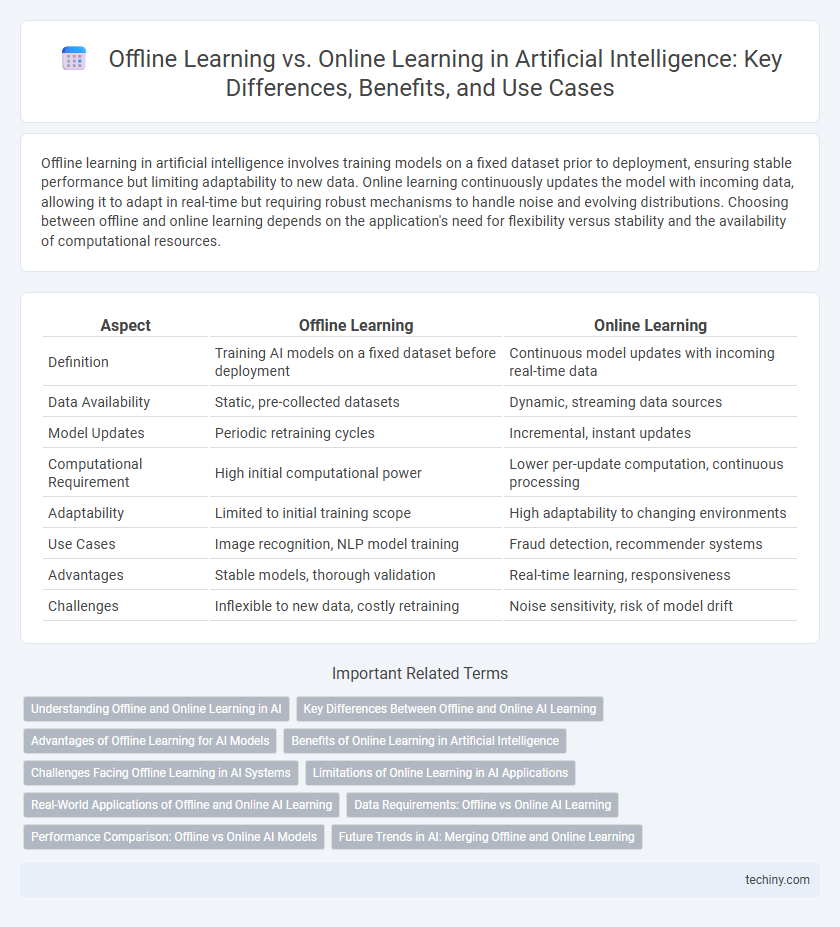Offline learning in artificial intelligence involves training models on a fixed dataset prior to deployment, ensuring stable performance but limiting adaptability to new data. Online learning continuously updates the model with incoming data, allowing it to adapt in real-time but requiring robust mechanisms to handle noise and evolving distributions. Choosing between offline and online learning depends on the application's need for flexibility versus stability and the availability of computational resources.
Table of Comparison
| Aspect | Offline Learning | Online Learning |
|---|---|---|
| Definition | Training AI models on a fixed dataset before deployment | Continuous model updates with incoming real-time data |
| Data Availability | Static, pre-collected datasets | Dynamic, streaming data sources |
| Model Updates | Periodic retraining cycles | Incremental, instant updates |
| Computational Requirement | High initial computational power | Lower per-update computation, continuous processing |
| Adaptability | Limited to initial training scope | High adaptability to changing environments |
| Use Cases | Image recognition, NLP model training | Fraud detection, recommender systems |
| Advantages | Stable models, thorough validation | Real-time learning, responsiveness |
| Challenges | Inflexible to new data, costly retraining | Noise sensitivity, risk of model drift |
Understanding Offline and Online Learning in AI
Offline learning in AI involves training models on a fixed dataset before deployment, ensuring stable performance through batch processing of data. Online learning continuously updates the AI model with new data in real-time, enhancing adaptability to evolving patterns and environments. Understanding the trade-offs between offline learning's efficiency and online learning's flexibility is crucial for optimizing AI applications across dynamic domains.
Key Differences Between Offline and Online AI Learning
Offline AI learning processes data in batches, enabling extensive analysis without real-time updates, which suits static datasets and model training with high computational resources. Online AI learning adapts continuously by processing data streams in real time, allowing models to evolve with new information and handle dynamic environments efficiently. Key differences include data processing methods, model update frequency, and suitability for either stationary or changing data distributions.
Advantages of Offline Learning for AI Models
Offline learning enables AI models to train on large, pre-collected datasets, ensuring comprehensive data coverage and minimizing real-time computational demands. This approach allows extensive hyperparameter tuning and model validation without the need for continuous data streaming, enhancing model stability and accuracy. Offline learning also safeguards sensitive data by restricting training to secure environments, reducing exposure risks inherent in real-time data ingestion.
Benefits of Online Learning in Artificial Intelligence
Online learning in Artificial Intelligence enables continuous model updates with streaming data, enhancing adaptability to real-time changes. It reduces the need for extensive retraining by incrementally incorporating new information, which conserves computational resources. This approach supports rapid deployment in dynamic environments, improving decision-making accuracy and responsiveness.
Challenges Facing Offline Learning in AI Systems
Offline learning in AI systems faces significant challenges, including limited adaptability to new data and inability to update models in real-time, which hinders responsiveness to dynamic environments. The static nature of offline training often results in outdated models that struggle with concept drift, reducing accuracy and effectiveness in practical applications. High computational costs and extensive data storage requirements further complicate the scalability and deployment of offline learning solutions.
Limitations of Online Learning in AI Applications
Online learning in AI faces limitations such as vulnerability to noisy data and concept drift, which can degrade model performance over time. The lack of access to complete datasets restricts the model's ability to learn comprehensive patterns, leading to potential inaccuracies. Moreover, online learning algorithms often struggle with stability-plasticity balance, hampering their effectiveness in dynamic environments.
Real-World Applications of Offline and Online AI Learning
Offline learning in artificial intelligence enables models to train on extensive, pre-collected datasets, ensuring stability and consistency ideal for applications like image recognition and fraud detection. Online learning adapts algorithms in real time by continuously processing streaming data, which is critical for dynamic environments such as personalized recommendations and autonomous driving. Real-world AI deployments often combine offline pre-training with online fine-tuning to balance robustness and adaptability in complex tasks.
Data Requirements: Offline vs Online AI Learning
Offline AI learning requires access to large, fully labeled datasets that enable models to be trained in a static environment, ensuring thorough data preprocessing and quality control. In contrast, online AI learning processes data streams in real-time, adapting continuously to new inputs without needing an extensive pre-collected dataset. This dynamic approach significantly reduces initial data requirements but demands efficient algorithms capable of incremental learning and handling evolving data distributions.
Performance Comparison: Offline vs Online AI Models
Offline AI models typically achieve higher accuracy due to extensive training on large, static datasets, enabling comprehensive pattern recognition and model fine-tuning. Online AI models excel in adaptability by continuously updating with new data, maintaining performance in dynamic environments but often at the cost of increased computational resources and occasional instability. Performance comparison highlights that offline learning is preferred for tasks requiring high precision, while online learning suits real-time applications with evolving data streams.
Future Trends in AI: Merging Offline and Online Learning
Future trends in AI emphasize the convergence of offline learning's robust model pretraining with online learning's real-time adaptability, creating hybrid systems that continuously refine decision-making from static datasets and live data streams. Advanced algorithms integrating incremental updates with deep neural networks aim to enhance personalization and responsiveness in applications like autonomous systems and personalized healthcare. This fusion promises improved computational efficiency, enabling AI to operate effectively in dynamic environments while minimizing retraining costs.
Offline Learning vs Online Learning Infographic

 techiny.com
techiny.com